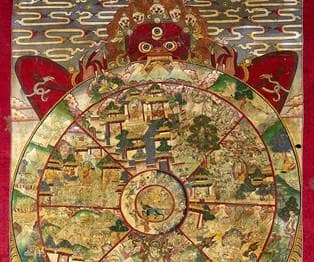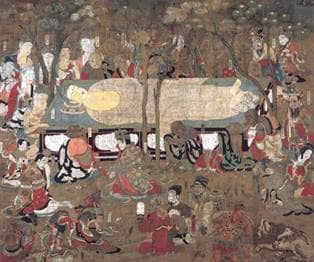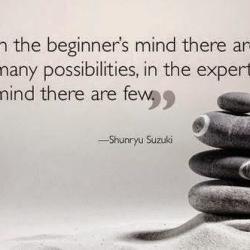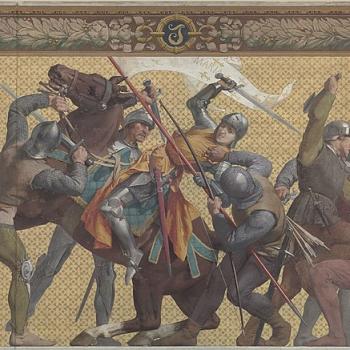- Trending:
- Forgiveness
- |
- Resurrection
- |
- Joy
- |
- Afterlife
Buddhism Beliefs
Sacred Narratives
The most recognized of sacred narratives in Buddhism is the life story of Gautama Siddhartha, who became the Buddha. Many of the teachings of Buddhism are implicit within the story of his life, and carvings and paintings of scenes from his life story were often placed in or around temples and on stupas. Equally recognized in the Buddhist world are the Jataka Tales, which tell of the Buddha's past lives.
Another type of sacred narrative that has been vitally important to Buddhism is stories from the Buddha's sermons. Both the early sutras and the later Mahayana sutras are often presented as long narratives. They often begin with the words, "This is what I heard," and they include descriptions of scenes, a cast of characters, and dialogue. Within these long narratives, there are many specific stories said to have been told by the Buddha to illustrate the dharma, or Buddhist teachings.
Today, a few of these sutras have become so popular that sects of Buddhism are devoted entirely to them. One of these is the Lotus Sutra. Within the Lotus Sutra, which in English translation runs to over three hundred pages, there are many stories that convey a "message" to the listener. The most famous of these is a story that illustrates the doctrine of skillful means (expedient means). The story tells of a rich man and his young sons who lived in a huge old crumbling house with only one exit. One day the house caught fire. The man's sons were inside playing, oblivious to the danger. The man warned them, but they were enjoying their games and did not heed his warning. He knew he did not have much time to save them, and that he needed skillful means to get them to leave the burning house. Thus the man told them of rare and desirable toys waiting for them outside the gate — goat-carts, deer-carts, and ox-carts — and his sons left the house to get their new toys. The man had to use "skillful means" to get them to leave, lying to them to save their lives. When they got outside and wondered aloud where the new carts were, the man made for each of them a large carriage even more resplendent than the carts he had promised.
After telling this story, the Buddha compared himself to that rich man, saying that he was like a father to the entire world, and that he had come to earth to rescue all living beings from the fires of birth, sickness, old age, death, stupidity, misunderstanding, suffering, and the three poisons of greed, anger, and delusion. Because people were unaware of the danger that surrounded them, like the rich man's sons, the Buddha offered them special powers, awareness, freedom, and spiritual pleasures. Like the boys in the story, people left the world of samsara seeking these gifts, and when they did, the Buddha gave them these gifts and more. He gave them the Great Vehicle, the Mahayana.
Another popular sutra is one that buttressed the growing lay movement within Mahayana Buddhism, the Vimalakirti Sutra. In this sutra, Vimalakirti is critical of the non-Mahayana schools, using the pejorative term Hinayana (small vehicle), because, he says, they are not interested in assisting others, but think only of their own enlightenment. Vimalakirti is then revealed as a bodhisattva who has incarnated to assist the Buddha in expounding the true ideals of the Mahayana.
For many lay people, the polemics in this sutra are less interesting than the fact that Vimalakirti was not a renunciant, but a wealthy lay follower of the Buddha. Many Buddhists had understood the Buddha's teachings to mean that one must renounce possessions and social connections to follow his teachings. Vimalakirti, however, was enlightened, like the Buddha, despite his wealth and lay status. The sutra thus validated the lay approach to Buddhism that became increasingly popular as Buddhism spread from India into other parts of Asia.
The Amitabha and Longer Amitabha Sutras tell the story of Dharmakara, who devoted millions of lifetimes to become Amitabha, the Buddha of the Pure Land. He was once a great king who gave up his throne to become a monk and began to practice the way of the bodhisattva. He went to the Buddha Lokesvararaja and expressed the wish that someday he could become a teacher to all living beings, and liberate all from suffering and rebirth.
Dharmakara then devoted five eons to cultivation and one hundred billion years of study to build up the required merit and design a Pure Land for living beings to go to after death. When his task was finally complete, he became the Buddha of this Pure Land, Amitabha. Now one has only to call the name Amitabha with sincerity at the moment of death, and one will be transported to this Pure Land, and will be exempt from rebirth. The Pure Land is beautiful and peaceful, but it also a place where one can continue to study Buddhism with the eventual goal of enlightenment and the dissolution of self.
There are many other popular sutras, including the Heart Sutra, the Diamond Sutra, and the Perfection of Wisdom Sutras, just to name a few. Some of these have, like the Lotus Sutra, become the focal points for particular sects of Buddhism, and adherents will copy and recite them to gain merit. These sutras and others contain stories that are learned by children and repeated by elders because of the wisdom of the lessons they contain.
- What is the most famous story within the Lotus Sutra, and what does it teach?
- Why are Mahayana and Hinayana schools of Buddhism referred to as the large and small vehicles, respectively?
- Why aren't the Buddhist sacred texts based solely upon the life of Gautama Siddhartha?
Ultimate Reality and Divine Beings
There is no Buddhist story about how the universe was originally created, as the Buddhist universe has no beginning in the sense that the Christian universe does. Early Buddhism shared an understanding of time and the nature of the universe with the Brahmanic religion of the time, which taught that the universe had been created and destroyed over and over again over vast periods of time. Within each cycle, there are stages, or kalpas, and the nature of existence is different in each stage. Later Buddhism expanded this vision to include multiple universes, each with its own Buddha and each of which is going through these cycles of creation and destruction.
According to Buddhism, ultimate reality is samsara, endless existence, but it is also impermanent, ever in flux, ever changing. It is empty, yet full. That is, form is always a temporary state of being. Some forms last for millennia, like mountains and oceans, and some are as brief as a lightning bolt. Elements come together to create a particular form, but eventually those elements will break apart again and the object will cease to exist. This is true of everything in the universe.
In contrast to this sophisticated philosophical view of ultimate reality, there are a variety of Buddhist descriptions of the composition of the universe. In one popular description borrowed from Hinduism, figurative rather than literal, there is a mountain, Mount Meru, surrounded by seven concentric circles of land. Outside these lands is a vast ocean, within which are four island continents. Some gods reside in heavens along the slopes of the mountain, or on top. Others reside in heavens above the mountain.
Another view of the universe is often portrayed in Buddhist paintings. Called the bhavacakra, or the Wheel of Life and Death, it depicts the universe as a series of concentric circles all within the grasp of Mara, the lord of death. Several realms for gods of different types and several different hells, as well as an animal realm and a realm for humans, are contained within the wheel.
As Buddhism evolved, the number of realms beyond the earthly realm expanded exponentially. Mahayana Buddhist texts describe many heavenly realms to which people can be reborn, including a number of Pure Lands, each with its own Buddha, as well many horrifying hells.
When Buddhism first began, there were no gods who were recognized as existing outside the realm of rebirth, or to whom one could appeal as saviors. Buddha taught that the gods are not exempt from death and rebirth, and while their lives may last for eons, they do eventually die, and are almost inevitably reborn in a lower realm because the life of a god is too great a distraction from the work that is necessary to achieve enlightenment. The Buddha taught that he was an ordinary man, and he said that those seeking salvation should look within themselves. According to the early texts, his final words were, "All the constituents of being are transitory; work out your salvation with diligence."
Paradoxically, the Buddha himself became the first "god" of Buddhism. Building on a notion from the early texts that the Buddha had an "emanation body" that could perform miraculous deeds, in some Mahayana Sutras he is portrayed as a god only pretending to be a man in order to inspire humanity.
As Mahayana Buddhism developed, many bodhisattvas ("enlightened beings") and Cosmic Buddhas emerged. The prototype of the bodhisattva in the Theravada texts is Sumedha, who was said to have become the Buddha in his last lifetime. Sumedha aspired to enlightenment, but having seen the Buddha Dipamkara, he decided that he would take the long path over many lifetimes to become a Buddha himself so that he could someday lead others to enlightenment. Until he was reborn as Gautama, and became the Buddha, he was reborn for many eons as a bodhisattva, developing the necessary "perfections" for full Buddhahood.
Thus the notion of bodhisattvas and Buddhas other than Gautama pre-exists Mahayana, but both were rare, and the early texts taught that there was no need for more than one Buddha as long as the teachings of the current Buddha were remembered. Only with the Mahayana were the notions of multiple bodhisattvas and multiple Buddhas fully developed. In Mahayana Buddhism monks aspired to become bodhisattvas rather than arhats, to bring enlightenment to all beings. Eventually the notion that all beings had Buddha within emerged, and some texts encouraged all Buddhists to aspire to become bodhisattvas.
A number of bodhisattvas were written about in the Mahayana texts and many have been embraced by popular culture. The monastic aspiration to become a bodhisattva gave way to the popular idea that one could call upon bodhisattvas for help. They became saviors, not only in spiritual realms, but also in the everyday world. For example, Avalokitesvara could, if one called out his name, rescue people from fires, floods, wild animals, and all sorts of dangers.
As Buddhism moved into China, Avalokitesvara changed gender and became female, and was known as Guanyin in China, Kannon in Japan. Many stories are told about her miraculous powers. Eventually multiple forms of Guanyin were revealed with different appearances and different specific abilities, such as healing illness or protecting pregnant women. One of the most striking forms is the thousand-armed Guanyin, each hand of which holds a different sacred implement.
Maitreya, the Buddha to come, is frequently seen represented in small good luck statues with a round tummy and laughing face. Jizo Bodhisattva is particularly popular in Japan as a protector of children. Amitabha is the Buddha of the Pure Land; one who calls his name at the moment of death will be instantly transported there, never to be reborn again. These are among thousands of deities worshipped in Buddhist countries today. Some are recognizable in form and iconography as having been in the Hindu pantheon; others are indigenous deities that have been transformed.
- Describe the role of creation and destruction in samsara.
- Who are the “saviors” of Buddhism?
- How has art enhanced our understanding of Buddhist beliefs?
Human Nature and the Purpose of Existence
Dependent origination, or dependent arising, is a formulation that is central to Buddhist philosophy. It is depicted as a wheel in the Bhavacakra, or Wheel of Life and Death, a popular subject for Buddhist paintings. According to the Divyavadana (Divine Stories), the original illustration was created by the Buddha while teaching the second noble truth to King Rudrayana.
In illustrations of dependent origination, the wheel is held in the grasp of Mara (or Yama), the lord of death. In the center of the wheel the three poisons are depicted — a pig, a snake, and a cock, representing delusion, anger, and greed. The next ring of the wheel shows the realms of existence: heavens, hells, and realms of humans and animals. On the outer edge of the wheel, the cycle of dependent origination is illustrated.
The Wheel of Life and Death is a depiction of the universe where all beings reside, but it is also the universe of each individual as he or she faces samsara. It is a map of the way that rebirth arises, of how human realities arise out of mental states. The cycle of dependent origination represents a human life cycle, but it can also represent cycles within a lifetime, such as the life cycle of an addiction, a relationship, a job, and so forth. The cycle of dependent origination can be brought to an end at any point in the cycle, although ignorance is typically the place to begin.
Rebirth begins with ignorance, and is sparked by one of the three poisons. Ignorance gives rise to volition, which gives rise to consciousness. Consciousness gives rise to a body (name and form), which gives rise to the six senses. The six senses lead to contact, which leads to sensations, which lead to desire. Desire gives rise to clinging, which leads to becoming. Becoming leads to birth, which gives rise to old age and death. Birth in this case is the creation of a set of predispositions that will structure one's volition in the next cycle.
For the western reader who cannot identify with the idea of samsara, dependent origination may be difficult to understand. An example might be helpful. Imagine that in a previous life you were an alcoholic. You've passed away, but the desire for alcohol is still strong within the part of yourself that survives. That part thinks, "If only I were alive again, I could drink." Eventually, from this desire a new life is created, and so the cycle of dependent origination begins again, with ignorance.
The cycle continues. You are unaware that drinking is not going to bring you the happiness you seek. You have been born with the volition to drink, as a result of the karma you have carried from your previous life. When you reach a certain age, you become conscious, and you become aware that you have a body, that you have been reborn. Chances are you have been born into a family of drinkers, since it is the motivating factor in your rebirth. You are around alcohol all the time; you can smell it, you can see it, you can experience it with your senses. As soon as you get the chance, you grab a drink and you drink it (contact). You have the sensation of a having a little buzz. This only makes you desire more drinks. You cling to the idea that drinking will bring you happiness. So you keep drinking, every chance you get. You are on your way to becoming an alcoholic. After awhile, your identity as an alcoholic is solidified — it is (re)born. Being a drinker is now an essential part of who you are. You live the rest of your life as an alcoholic, and then you die. After death, the desire for alcohol remains, and so the cycle begins yet again.
Just as suffering arises from the cycle of dependent origination, salvation can arise from understanding the causes of suffering, or, to put it another way, from eliminating the ignorance that has prevented recognition of the causes. Instead of living a cycle that leads to the rebirth of an identity as an alcoholic, you could develop the identity of an AA member. Or you could become a teetotaler. Or it could be that something else will become the focus of your identity, be it family, a profession, or a skill. Or you might realize that any identity is impermanent, an illusion. There are many ways you could overcome your ignorance and avoid that endless cycle of death and rebirth.
It is not necessary to interpret this cycle in terms of past lives. All humans experience cycles through which their identities are formed. For example, one may go to school and start a profession; one could fall in love and get married; or one might have children and become parents. Any cycle of this kind creates a sense of personal identity, and any negative cycle can be broken. Where problems arise, according to Buddhism, is when one begins to think of these characteristics of one's life as permanent and unchanging, as the whole of one's identity.
What is the purpose of life in Buddhism? There is no single answer to that question. If life is samsara, then the purpose is to escape from it. For some, life's purpose may be to recognize the true nature of existence and become enlightened, or to burn off karma in order to avoid future rebirths. For others, the purpose of life might be to accumulate merit so that one can be born to a better life next time, or perhaps someday to become a bodhisattva. For still others, the purpose of life is simply to follow the eightfold path.
In Chan (Japanese, Zen), the purpose of life is simply to live. All life is sacred; everything partakes of the nature of the Buddha, so one need only realize this to find meaning in one's life, and enlightenment.
- How does the Wheel of Life and Death illustration the formulation of Dependent Origination?
- Provide an example (other than alcoholism) of how the idea of dependent origination can be understood in Western thought.
- What does Buddhism contribute to the meaning of life?
Suffering and the Problem of Evil
The first sermon that the Buddha preached after his enlightenment concerned the Four Noble Truths. This is the most well known of Buddhist doctrines in the west, and there are some fairly standard English translations ("Life is suffering. The cause of suffering is desire," and so forth), but the standard translations are somewhat misleading. First, these are not truths that are noble, but truths that have been realized by the (spiritually) noble. They might more accurately be called four realities of life known to those who are spiritually aware. These four realities are: the truth of suffering, the truth of arising, the truth of cessation, and the truth of the path.
Suffering: The word often translated as suffering has no English equivalent. The meaning of the phrase is not that "life is miserable," as the English translation might seem to indicate, but that some pain is inevitable in life. Birth is painful, sickness is painful, aging is painful, death is painful. It is painful to experience unhappiness and displeasure; it is painful to want something and not be able to have it; it is painful to have something and lose it; it is painful when a pleasurable experience ends.
What the Buddha had been seeking when he became enlightened was a way out of samsara, the endless cycle of death and rebirth. The Hindu texts, the Upanishads, which were written at around the same time, had argued that the way out of the endless cycle of death and rebirth was to realize that one's individual self or soul (atman) is a part of the world soul (Brahman).
Some scholars argue that the Buddha's solution to end this cycle was to realize that there is no self, no atman. If there is no self, there is nothing to reincarnate, nothing to endure this endless cycle. Others scholars argue that Buddha refused to answer questions about the self, and that to deny the existence of the self is just as much of an obstacle as is the self.
According to textual accounts of his first sermon, written long after his death, what the Buddha said was that the forms of suffering he listed (birth, sickness, aging, loss, etc.) are examples of "the five aggregates subject to clinging." These five aggregates, or skandhas, are what makes up the self: form, sensation, perception, mental formations, and consciousness. Each of these constituents is constantly changing, constantly in flux; therefore the "self" is also constantly changing. Thus while there may be an experience of selfhood, there is no permanent, unchanging self.
Arising: Humans tend to long for what they do not have, or to wish for their lives to be different than they are; they often fail to fully appreciate what they do have. This longing (craving, desire) gives rise to, or causes, a new cycle of life and death.
The Four Noble Truths are often understood as a series of propositions, or as a prescription for approaching disease: symptom/cause/elimination of cause/remedy. In this formulation, cause, or arising, is the pivotal moment. Buddhist scholar Donald Lopez says, "If it is possible to identify a particular contribution of the Buddha to the philosophies of his day, it would be the thoroughgoing emphasis on causation as an inexorable force whose devastating effects can be escaped by understanding its operation. That is, everything is an effect of a cause. If the cause can be identified and destroyed, the effect is also destroyed."
Cessation: It is possible to stop this cycle.
Path: The path to the end of suffering is the Noble Eightfold Path (that is, the eightfold path for the spiritually aware): right view, right intention, right speech, right action, right livelihood, right effort, right mindfulness, right concentration.
This remedy of the Eightfold Path may seem like a moral answer to a philosophical problem, and to some extent, it is. Ashoka, when spreading his edicts about the teachings of Buddhism, focused on moral guidelines rather than complex philosophical ideas. On another level, this list is a response to the audience, to which it is addressed, the men with whom Buddha had practiced extreme asceticism before deciding that it was not the right path for him. According to the texts, the Buddha began his sermon by saying that one should follow a middle path between asceticism and hedonism, and then he listed the elements of the Eightfold Path, repeating them again shortly afterward when presenting the four truths. Thus, one meaning of the Eightfold Path is that extreme approaches to seeking enlightenment are not necessary.
In Buddhism, while life may be full of suffering, it is not evil, nor are there evil entities in the world tempting people to sin and self-destruction. This is not to say that there are no demonic forces in the Buddhist world. There are demons that can cause disease or other misfortunes, and demons to punish wrongdoers in the Buddhist hells, but an angry deceased relative can be equally dangerous.
Often Buddhists enlist demons into the service of the good. For example, before beginning to make a sand mandala, Tibetan monks will capture demons and install them at the four corners of the mandala to protect it. In Japan one can obtain a "traffic demon" amulet as protection from automobile accidents. Buddhists have long been regarded as specialists who can be counted on to defeat or convert demons, which they do through spells, rituals, or dialogue. They may also transfer merit or otherwise meet the spiritual need of the demon, and thus convert it.
If there is "evil" in Buddhism, it is the greed, anger, and delusion that give rise to samsara. Human nature is not evil, per se, but it can give rise to suffering. The goal of the Buddha's dharma is not to eliminate all suffering or to create a perfect life or world, but to learn how best to deal with the suffering that is a normal part of human life.
- How has western translation contributed to a misunderstanding of Buddhism's teachings?
- How can one break the cycle of samsara?
- How do the four noble truths contrast to western medicine's methodology of treating disease?
Afterlife and Salvation
Buddhism began as a way to address the suffering that exists in the world, and was not overly-focused on ultimate salvation. That said, however, there was a clear doctrine of salvation in the Buddha's teachings: Salvation in early Buddhism was nirvana, the extinguishing of the all karma that constitutes the self. Nirvana is not a place or a state, but the end of rebirth.
Significantly, the Buddha said little about nirvana, because he felt that the alleviation of suffering was far more important, and that focusing on the goal of ultimate salvation would only lead to more attachments, and therefore more suffering. Rather than focus on nirvana as a goal, therefore, lay Buddhists were encouraged to give donations of goods, services, or money to monks or monasteries; to chant or copy sutras; and to engage in other activities in order to gain merit that could lead to a more desirable rebirth, which would bring them closer to enlightenment.
Some Mahayana Buddhist monks aspired to become bodhisattvas, postponing the dissolution of self until all living things are enlightened. For seminal religious figures and heads of religious orders in Tibet, this took the unusual form of continued incarnations in human form as the same individual, lifetime after lifetime. The current Dalai Lama is called the 14th, for example, because this is believed to be his 14th incarnation as the Dalai Lama.
The notion of skillful means in Mahayana Buddhism led to other interpretations of salvation, such as rebirth in a Pure Land, where one could continue to aspire to enlightenment in pleasant surroundings without fear of rebirth in human form. Mahayana texts also refer to hells into which one might be reborn, usually in the context of rescuing others from a hellish domain, or transferring merit to those in such a place. There is also reference in the earliest texts to Yama, a deity of death who will judge and punish those who do evil. The punishment is not eternal, but lasts until the karma of these misdeeds has been exhausted.
As Buddhism evolved and as it moved to other countries with different religious backgrounds, other views of the afterlife emerged. Yama became a central figure in popular understandings of the afterlife in East Asia and also in Tibet. Tibetan Buddhists also envisioned the Bardo, a kind of limbo where the soul or self remained until the next rebirth.
In the Chinese tradition, where ancient notions of the role of the ancestors in human life have shaped Buddhism, people burned incense and paper goods depicting goods or money for the benefit of their deceased loved ones in order to provide a better situation for them in the afterlife. The deceased, in turn, were believed to be able to bring benefits or cause harm to the living.
Notions of heavens and hells eventually became a part of popular Buddhism throughout Asia. These range from ideal surroundings such as the Pure Lands to horrific worlds of punishment and suffering. Illustrated "hell texts" are popular among in some Buddhist countries, depicting in detail the punishments one can expect for a host of specific misdeeds, which may range from wearing tight blue jeans to murder.
As should be evident, there is no single, consistent notion of the afterlife and salvation within Buddhism. There are diverse and contradictory ideas even within individual countries. This is the result of the merging of Buddhism with pre-existing conceptions, of contradictions between scholarly and popular understandings, and of the evolution of ideas within Buddhism throughout the life of the religion.
- Contrast a few of the varying Buddhist beliefs about the death.
- Why does Buddhism lack a consistent idea of salvation?
- Why is nirvana often deemphasized in Buddhism?








